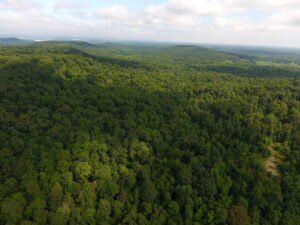By Bernheim
 Bernheim Arboretum and Research Forest continues to fight utility giant LG&E to protect our conservation land against a proposed natural gas pipeline that threatens the integrity of one of Kentucky’s most pristine forests. LG&E is suing Bernheim and a state agency to take private land through condemnation under the power of eminent domain and forever disrupt Bernheim’s ecosystem and the rare plant and animal species that have been protected here for more than 90 years.
Bernheim Arboretum and Research Forest continues to fight utility giant LG&E to protect our conservation land against a proposed natural gas pipeline that threatens the integrity of one of Kentucky’s most pristine forests. LG&E is suing Bernheim and a state agency to take private land through condemnation under the power of eminent domain and forever disrupt Bernheim’s ecosystem and the rare plant and animal species that have been protected here for more than 90 years.
The Kentucky Public Service Commission (PSC) must consider requests for a “certificate of public convenience and necessity” for pipelines planned by a utility company that are not “ordinary extensions of existing systems in the usual course of business.” When these requests and considerations are reviewed and authorized with little or no public input, as they were for LG&E, taxpayers and utility customers carry the financial burden without being given an opportunity to voice their concerns.
Yet there is a greater and longer-term public need that is ignored in the PSC/utility company process – conservation of land and protection of a healthy environment. LG&E’s request to construct a pipeline was approved without consideration of the enormous environmental consequences. Natural lands provide clean water and air, wildlife habitat, recreational opportunities, ecotourism and beauty for generations. Conservation is a public need and a necessity that helps ensure a high quality and healthy life for everyone in a community. The state hold’s Bernheim’s conservation easements as a principal public trust-based responsibility for protecting, not destroying, the natural resources under its purview.
LG&E claims the pipeline will only impact a small percentage of Bernheim land. Any destruction of land would do irreversible harm. LG&E would be breaking the legal protections of a conservation easement, thus setting a dangerous precedent for conservation lands everywhere. The 4,000-foot long by 75-foot wide construction zone would destroy eight acres of forest, reducing the effectiveness of Bernheim’s Cedar Grove Wildlife Corridor by forever prohibiting forest regrowth on the land.
Bernheim has been planning wildlife corridors via land extensions for more than 11 years, long before LG&E approached the Public Service Commission with confidential plans about the proposed pipeline route. We began active negotiations with the previous owners in 2013, who repeatedly expressed their interest in preserving the land. Landowners have the right to permanently protect the integrity of their land.
A previous landowner granted an easement for an Eastern Kentucky Power Cooperative (EKPC) transmission line, however EKPC will not allow LG&E the use of their existing easement. Therefore, LG&E would need to widen the existing forest scar. This will destroy springs, muddy creeks, and eliminate rare habitats and animals.
The proposed pipeline route runs through a vital wildlife corridor. Bobcats, bats, birds and other wildlife use every acre of Bernheim, for they know no borders and require space to feed, find mates and raise offspring. Two extremely rare species of snails have also been discovered in the proposed pipeline path, with one possibly being a species entirely new to science. Their very existence indicates pure limestone-filtered water that can only be found in untouched springs.
LG&E studied many possible routes to service its customers, but moved forward with its plans without public input. The simple fact is alternative routes that would not destroy conservation lands do exist. Bernheim cannot move its trees; LG&E can move the pipeline route. It is time for LG&E to move to plan B and remember there is no Planet B.
Bernheim is legally and morally obligated to fight this non-conservation use of land protected by conservation easements and deed restrictions. We encourage LG&E to take this opportunity to be a leader in environmental protection, reinstate its energy conservation and renewable energy programs, and choose a path forward that leaves Kentucky’s protected forests in tact.
Bernheim Arboretum and Research Forest has been a living legacy of philanthropist and visionary, Isaac W. Bernheim, since 1929. More than 500,000 visitors from the U.S. and abroad visit Bernheim each year. This potential seizure of our pristine conservation land ignores the easements put in place to protect our biologically diverse land. Should the pipeline be built, it will have an irreversible impact on our clean air and water, our visitors, and the quality of life in our community. This dangerous precedent of breaking a conservation easement makes this a bigger issue than just Bernheim – we are fighting for conservation protections everywhere.
We need the public’s support to help eliminate this threat. Join the fight to #SaveBernheim at ForestUnderThreat.com.

